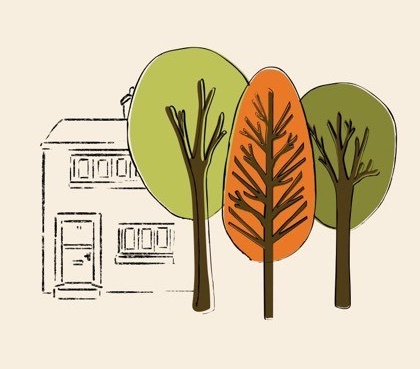Conservation Report - Location and Topology
Location, Geology, Topography
The Luddenden valley is set in the Pennine chain of hills. About 300-350 million years ago, much of what is now northern England was covered by a river delta.
Large amounts of sand were deposited by the river, and at times the land was above the water, whilst at others, it was submerged. At the end of this period, the land started to rise in what is known as the Armorican mountain building period, and the Pennine hills were pushed up, much higher than they now are. The apex of the Pennines runs in a north-south direction. To the east, the hills dip down towards the plain of York, and there is a similar but steeper dip to the west. The Calder Valley roughly follows this dip slope to the east, whilst the Luddenden valley lies north-south, but with the upper portion deflected westwards, as the stream follows the dip to the east.
The solid rock of the Pennines consists of an alternation of grit, sandstones or flagstones with soft shale or mudstones. This frequent alternation of hard and soft beds, combined with the easterly dip, gives rise to the characteristic type of scenery when viewed from a distance, as shown below.
The Luddenden valley has been formed by the stream from the edge of the plateau cutting deeply into the soft rocks.
Just below Luddenden, however, the region where the Kershaw estate is situated was formed much more recently. At the end of the Ice Age, perhaps 10,000 years ago, melt waters from a big ice sheet in Lancashire flowed down from the Rochdale direction and the Burnley direction to join at Todmorden, and thence eastwards, cutting out the Calder Valley as they came. The waters carried vast amounts of sand and stones, and when they had all flowed into what is now the North Sea, great piles of this rubble were left deposited in what is called glacial moraine. The round-backed hill between Upper Foot and the Kershaw estate is one such. Some years ago, when a garage was being built on the estate and foundations were being dug, a large, perfectly round stone the size of a football and weighing about 10Kg was dug out.
This could only have been made perfectly round by being carried and worn away in water, similar to pebbles on a beach.
The moorland on the summit is formed of recent drift material and peat. Below this outcrops a rock called the ‘rough rock’ and below this the millstone grit, where there is this succession of hard and soft beds of sandstone and shale. Locally, this hard layer of millstone grit is called the Midgley bed, and both the rough rock and Midgley beds have been extensively quarried in the Luddenden valley for flagstones and for building stones respectively. Even within the Conservation Area itself, there are small areas where this gritstone has been quarried to use in house building, for example at Snail Quarry on the left 50 metres past the junction with New Road on the bottom road into Luddenden, behind Quarry House.
